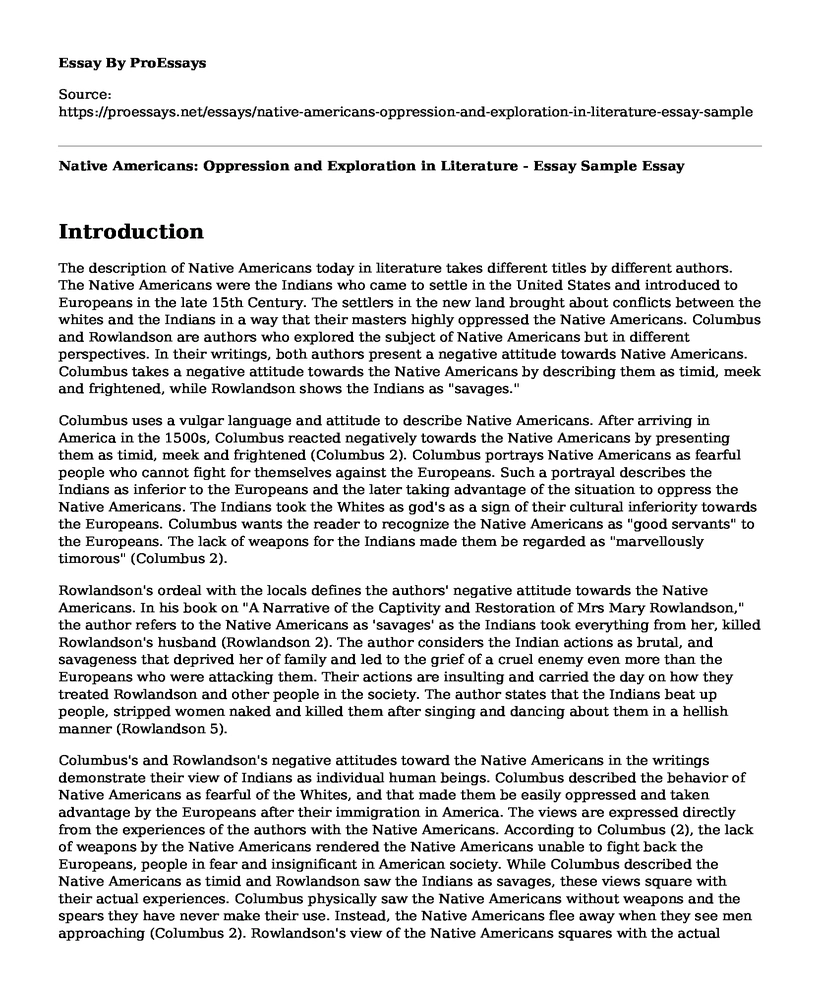Introduction
The description of Native Americans today in literature takes different titles by different authors. The Native Americans were the Indians who came to settle in the United States and introduced to Europeans in the late 15th Century. The settlers in the new land brought about conflicts between the whites and the Indians in a way that their masters highly oppressed the Native Americans. Columbus and Rowlandson are authors who explored the subject of Native Americans but in different perspectives. In their writings, both authors present a negative attitude towards Native Americans. Columbus takes a negative attitude towards the Native Americans by describing them as timid, meek and frightened, while Rowlandson shows the Indians as "savages."
Columbus uses a vulgar language and attitude to describe Native Americans. After arriving in America in the 1500s, Columbus reacted negatively towards the Native Americans by presenting them as timid, meek and frightened (Columbus 2). Columbus portrays Native Americans as fearful people who cannot fight for themselves against the Europeans. Such a portrayal describes the Indians as inferior to the Europeans and the later taking advantage of the situation to oppress the Native Americans. The Indians took the Whites as god's as a sign of their cultural inferiority towards the Europeans. Columbus wants the reader to recognize the Native Americans as "good servants" to the Europeans. The lack of weapons for the Indians made them be regarded as "marvellously timorous" (Columbus 2).
Rowlandson's ordeal with the locals defines the authors' negative attitude towards the Native Americans. In his book on "A Narrative of the Captivity and Restoration of Mrs Mary Rowlandson," the author refers to the Native Americans as 'savages' as the Indians took everything from her, killed Rowlandson's husband (Rowlandson 2). The author considers the Indian actions as brutal, and savageness that deprived her of family and led to the grief of a cruel enemy even more than the Europeans who were attacking them. Their actions are insulting and carried the day on how they treated Rowlandson and other people in the society. The author states that the Indians beat up people, stripped women naked and killed them after singing and dancing about them in a hellish manner (Rowlandson 5).
Columbus's and Rowlandson's negative attitudes toward the Native Americans in the writings demonstrate their view of Indians as individual human beings. Columbus described the behavior of Native Americans as fearful of the Whites, and that made them be easily oppressed and taken advantage by the Europeans after their immigration in America. The views are expressed directly from the experiences of the authors with the Native Americans. According to Columbus (2), the lack of weapons by the Native Americans rendered the Native Americans unable to fight back the Europeans, people in fear and insignificant in American society. While Columbus described the Native Americans as timid and Rowlandson saw the Indians as savages, these views square with their actual experiences. Columbus physically saw the Native Americans without weapons and the spears they have never make their use. Instead, the Native Americans flee away when they see men approaching (Columbus 2). Rowlandson's view of the Native Americans squares with the actual experiences of seeing the Indians killed her husband and children. The author describes the heart-aching thoughts experienced after her poor children were "scattered up and down among the wild beasts of the forest" (Rowlandson 5). These are painful experiences that support the view of Rowlandson regarding Native Americans as harmful people.
Conclusion
In conclusion, Columbus's and Rowlandson attitudes toward the Native Americans in their writings are negative. Columbus describes the Indians as fearful people while Rowlandson sees the Native Americans as dangerous people. A close examination of the attitudes of the authors regarding the Native Americans take individual human beings stance and that squares with their actual experiences with the Indians.
Works Cited
Columbus, Christopher (1451-1506). Unit 2: Pre-Colonial America and Colonial Settlements.
Columbus, Christopher. Selections from a Letter to King Ferdinand of Spain, Describing the Results of the First Voyage, March 4, 1493.
Rowlandson, Mary. Narrative of the Captivity and Restoration of Mrs Mary Rowlandson. John Boyles Printing Office.
Cite this page
Native Americans: Oppression and Exploration in Literature - Essay Sample. (2023, May 03). Retrieved from https://proessays.net/essays/native-americans-oppression-and-exploration-in-literature-essay-sample
If you are the original author of this essay and no longer wish to have it published on the ProEssays website, please click below to request its removal:
- Ars Poetica by Archibald MacLeish - Critical Thinking Example
- The Process of Achieving Cultural Competency
- Essay on Organization of Sporting Events for Success: Football Guidelines
- Essay on Universal Themes and Characters in Death of a Salesman
- Challenges to Colonialism in Shakespeare's The Tempest Essay Example
- Essay Example on Authenticity in I Am Not Your Perfect Mexican Daughter by Ericka Sanchez
- The Epic Tales of David & Goliath & The Odyssey - Essay Example







